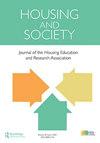有残疾成员的家庭和需要长期服务和支持的家庭的住房和邻里严重不平等
Q2 Social Sciences
引用次数: 2
摘要
越来越多的研究强调住房安全是健康社区生活的关键决定因素。另一项研究发现,有残疾人的家庭更有可能生活在质量较差的住房和社区,这对他们参与社区和健康生活的能力构成了挑战。在本文中,我们关注两个群体的住房安全指标,即有残疾成员的家庭和有残疾成员的家庭需要长期服务和支持(LTSS)。我们的实证目标有两个:1)扩展现有的关于残疾家庭与非残疾家庭在住房保障方面的差异的研究;2)比较LTSS残疾家庭、非LTSS残疾家庭和非残疾家庭的住房保障。根据2017年美国住房调查数据,我们从三个方面衡量住房安全:住房质量、社区质量和住房负担能力。加权描述性分析和多变量logistic回归表明,有残疾成员的家庭和LTSS残疾家庭的住房结果一致最差。尽管有共同的努力和联邦法律,LTSS残疾家庭仍然生活在比非LTSS残疾家庭质量更差的住房和社区中。解决这些住房不平等问题对于使残疾人能够过上更健康和融入社区的生活至关重要。本文章由计算机程序翻译,如有差异,请以英文原文为准。
Severe housing and neighborhood inequities of households with disabled members and households in need of long-term services and supports
Abstract A growing body of research underscores housing security as a critical determinant of healthy community living. Another body of research finds that households with people with disability are more likely to live in poor-quality housing and neighborhoods, challenging their ability for community engagement and healthy living. In this paper we focus on housing security indicators for two groups, households with a disabled member and households with a disabled member in need of long-term services and supports (LTSS). Our empirical goals are twofold: 1) Extend existing research on disparities in housing security for households with a disabled member compared to non-disability households overall, and 2) Compare housing security among LTSS disability, non-LTSS disability, and non-disability households. Using 2017 American Housing Survey data, we measure housing security in three areas: housing quality, neighborhood quality, and housing affordability. Weighted descriptive analysis and multivariate logistic regressions show that households with members with disabilities overall and LTSS disability households specifically consistently have the worst housing outcomes. Despite concerted efforts and federal law, LTSS disability households continue to live in poorer-quality housing and neighborhoods than non-LTSS disability households. Addressing these housing inequities is critical to enable people with disabilities to live healthier and community-integrated lives.
求助全文
通过发布文献求助,成功后即可免费获取论文全文。
去求助
来源期刊

Housing and Society
Social Sciences-Urban Studies
CiteScore
2.30
自引率
0.00%
发文量
10
期刊介绍:
Housing and Society is the journal of the Housing Education and Research Association (HERA). The journal supports the mission of HERA by providing for the dissemination of research and other scholarly work. Submissions from a broad range of perspectives are encouraged. Topics in housing include: policy, design, social aspects, gerontology, behavioral aspects, energy/environment, equipment, interiors, economics, theory/model development, education, and program development or evaluation. The journal welcomes the submission of original research articles, notes and commentaries. Notes are shorter manuscripts presenting succinct information on housing related to one of the following categories: - Research: exploratory or not heavily theory-based or statistically analyzed - Academic: innovative teaching ideas - Program: development, implementation, and/or evaluation of Cooperative Extension or other housing programming efforts - Policy: examination of policy impact, comparative analysis, and/or need to achieve housing goals - Reviews: books, documentaries, etc.
 求助内容:
求助内容: 应助结果提醒方式:
应助结果提醒方式:


